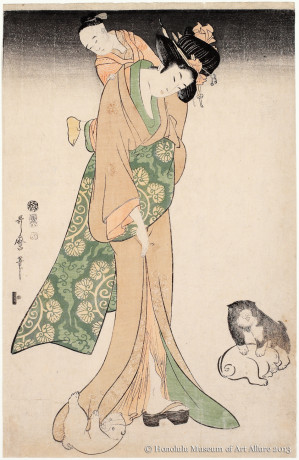Kitagawa Utamaro (1753-1806)
Mother and Child with Puppies
Japan, Edo period, c. 1800
Woodblock print; ink and color on paper
Gift of James A. Michener, 1987
Honolulu Museum of Art
(20012)
Utamaro had an interest in familial relationships unusual in ukiyo-e. While his corpus contained the standard subjects of courtesans and the Yoshiwara, and a number of exceptional examples of shunga (literally “spring pictures,” or erotic art), he also expanded depictions of beauty in Japanese prints to include sisters, mothers and children. A Weakness for Love in this exhibition portrays a younger and older sister, while both Lover of Loud Noises and the present work focus on motherly love, a rare subject indeed in ukiyo-e as a whole.
Although Utamaro already had developed the ōkubi-e format for which he would become best known, here he chose to depict the mother in a full-length pose, struggling with both the child on her back and the puppies at her feet (one of which wrestles with her robe to reveal her calf, recalling a technique for introducing a sense of voyeuristic titillation common in portrayals of courtesans).
At the same time, unlike his contemporary Kiyonaga, who favored elaborate settings, Utamaro has eliminated background elements to draw attention to the main subjects, typical of his ōkubi-e, as well. Towards the end of the 18th century, fashions changed to give increasing emphasis to wide, richly brocaded obi, placed against kimono in contrasting colors with more subtle patterns, reflected in the mother’s style of dress.
View info on museum database (enabled through support by the Robert F. Lange Foundation)


